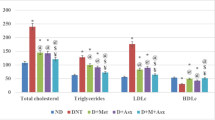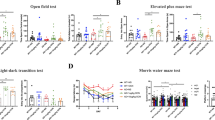Abstract
Aim:
Oxymatrine (OMT) is the major quinolizidine alkaloid extracted from the root of Sophora flavescens Ait (the Chinese herb Kushen) and exhibits diverse pharmacological actions. In this work we investigated the effects of OMT on diabetes-associated cognitive decline (DACD) in a rat model of diabetes and explored the mechanisms of action.
Methods:
Male Wistar rats were injected with streptozotocin (65 mg/kg, ip) once to induce diabetes. The rats were then treated with vehicle or OMT (60 or 120 mg/kg per day, ip) for 7 weeks. Memory function was assessed using Morris water maze test. The levels of malondialdehyde (MDA), superoxide dismutase (SOD), glutathione (GSH), NF-κB p65 unit, TNF-α, IL-1β and caspase-3 in the cerebral cortex and hippocampus were quantified.
Results:
The diabetic rats exhibited markedly reduced body weight and increased plasma glucose level. The memory function of the rats assessed using Morris water maze test showed significant reduction in the percentage of time spent in the target quadrant and the number of times crossing the platform, coupled with markedly prolongation of escape latency and mean path length. Moreover, the rats showed oxidative stress (significantly increased MDA, decreased SOD and reduced GSH levels), as well as significant increases of NF-κB p65 unit, TNF-α, IL-1β and caspase-3 levels in the cerebral cortex and hippocampus. Chronic treatment with OMT dose-dependently reversed these behavioral, biochemical and molecular changes in the diabetic rats. However, the swimming speed had no significant difference among the control, diabetic and OMT-treated diabetic rats.
Conclusion:
Chronic treatment with OMT alleviates diabetes-associated cognitive decline in rats, which is associated with oxidative stress, inflammation and apoptotic cascades.
Similar content being viewed by others
Log in or create a free account to read this content
Gain free access to this article, as well as selected content from this journal and more on nature.com
or
References
McCrimmon RJ, Ryan CM, Frier BM . Diabetes and cognitive dysfunction. Lancet 2012; 379: 2291–9.
Biessels GJ, Deary IJ, Ryan CM . Cognition and diabetes: a lifespan perspective. Lancet Neurol 2008; 7: 184–90.
Bloomgarden ZT . Diabetic neuropathy. Diabetes Care 2007; 30: 1027–32.
Dobretsov M, Romanovsky D, Stimers JR . Early diabetic neuropathy: triggers and mechanisms. World J Gastroenterol 2007; 13: 175–91.
Mijnhout GS, Scheltens P, Diamant M, Biessels GJ, Wessels AM, Simsek S, et al. Diabetic encephalopathy: A concept in need of a definition. Diabetologia 2006; 49: 1447–8.
Kodl CT, Seaquist ER . Cognitive dysfunction and diabetes mellitus. Endocr Rev 2008; 29: 494–511.
Elias MF, Elias PK, Sullivan LM, Wolf PA, D'Agostino RB . Obesity, diabetes and cognitive deficit: the framingham heart study. Neurobiol Aging 2005; 26: 11–6.
Brown CM, Marthol H, Zikeli U, Ziegler D, Hilz MJ . A simple deep breathing test reveals altered cerebral autoregulation in type 2 diabetic patients. Diabetologia 2008; 51: 756–61.
Reagan LP, Grillo CA, Piroli GG . The As and Ds of stress: metabolic, morphological and behavioral consequences. Eur J Pharmacol 2008; 585: 64–75.
Wessels AM, Scheltens P, Barkhof F, Heine RJ . Hyperglycaemia as a determinant of cognitive decline in patients with type 1 diabetes. Eur J Pharmacol 2008; 585: 88–96.
Sharma B, Singh N . Behavioral and biochemical investigations to explore pharmacological potential of PPAR-gamma agonists in vascular dementia of diabetic rats. Pharmacol Biochem Behav 2011; 100: 320–9.
Fukui K, Onodera K, Shinkai T, Suzuki S, Urano S . Impairment of learning and memory in rats caused by oxidative stress and aging, and changes in antioxidative defense systems. Ann N Y Acad Sci 2001; 928: 168–75.
Angeli JK, Pereira CA, de Oliveira Faria T, Stefanon I, Padilha AS, Vassallo DV . Cadmium exposure induces vascular injury due to endothelial oxidative stress: the role of local angiotensin II and COX-2. Free Radic Biol Med 2013; 65: 838–48.
Umegaki H . Pathophysiology of cognitive dysfunction in older people with type 2 diabetes: vascular changes or neurodegeneration? Age Ageing 2010; 39: 8–10.
Kuhad A, Bishnoi M, Tiwari V, Chopra K . Suppression of NF-kappabeta signaling pathway by tocotrienol can prevent diabetes associated cognitive deficits. Pharmacol Biochem Behav 2009; 92: 251–9.
Mastrocola R, Restivo F, Vercellinatto I, Danni O, Brignardello E, Aragno M, et al. Oxidative and nitrosative stress in brain mitochondria of diabetic rats. J Endocrinol 2005; 187: 37–44.
Hong-Li S, Lei L, Lei S, Dan Z, De-Li D, Guo-Fen Q, et al. Cardioprotective effects and underlying mechanisms of oxymatrine against Ischemic myocardial injuries of rats. Phytother Res 2008; 22: 985–9.
Jiang H, Meng F, Li J, Sun X . Anti-apoptosis effects of oxymatrine protect the liver from warm ischemia reperfusion injury in rats. World J Surg 2005; 29: 1397–401.
Zheng P, Niu FL, Liu WZ, Shi Y, Lu LG . Anti-inflammatory mechanism of oxymatrine in dextran sulfate sodium-induced colitis of rats. World J Gastroenterol 2005; 11: 4912–5.
Zeng XY, Zhou X, Xu J, Chan SM, Xue CL, Molero JC, et al. Screening for the efficacy on lipid accumulation in 3T3-L1 cells is an effective tool for the identification of new anti-diabetic compounds. Biochem Pharmacol 2012; 84: 830–7.
Kuhad A, Chopra K . Effect of sesamol on diabetes-associated cognitive decline in rats. Exp Brain Res 2008; 185: 411–20.
Dong XQ, Yu WH, Hu YY, Zhang ZY, Huang M . Oxymatrine reduces neuronal cell apoptosis by inhibiting Toll-like receptor 4/nuclear factor kappa-B-dependent inflammatory responses in traumatic rat brain injury. Inflamm Res 2011; 60: 533–9.
Huang M, Hu YY, Dong XQ, Xu QP, Yu WH, Zhang ZY . The protective role of oxymatrine on neuronal cell apoptosis in the hemorrhagic rat brain. J Ethnopharmacol 2012; 143: 228–35.
Morris RG, Garrud P, Rawlins JN, O'Keefe J . Place navigation impaired in rats with hippocampal lesions. Nature 1982; 297: 681–3.
Wills ED . Mechanisms of lipid peroxide formation in animal tissues. Biochem J 1966; 99: 667–76.
Kono Y . Generation of superoxide radical during autoxidation of hydroxylamine and an assay for superoxide dismutase. Arch Biochem Biophys 1978; 186: 189–95.
Jollow DJ, Mitchell JR, Zampaglione N, Gillette JR . Bromobenzene-induced liver necrosis. Protective role of glutathione and evidence for 3,4-bromobenzene oxide as the hepatotoxic metabolite. Pharmacology 1974; 11: 151–69.
Cao Y, Mao X, Sun C, Zheng P, Gao J, Wang X, et al. Baicalin attenuates global cerebral ischemia/reperfusion injury in gerbils via anti-oxidative and anti-apoptotic pathways. Brain Res Bull 2011; 85: 396–402.
Ryan CM, Geckle MO, Orchard TJ . Cognitive efficiency declines over time in adults with Type 1 diabetes: effects of micro- and macrovascular complications. Diabetologia 2003; 46: 940–8.
Lobnig BM, Kromeke O, Optenhostert-Porst C, Wolf OT . Hippocampal volume and cognitive performance in long-standing Type 1 diabetic patients without macrovascular complications. Diabet Med 2006; 23: 32–9.
Zhang K, Li YJ, Yang Q, Gerile O, Yang L, Li XB, et al. Neuroprotective effects of oxymatrine against excitotoxicity partially through down-regulation of NR2B-containing NMDA receptors. Phytomedicine 2013; 20: 343–50.
Nishikawa T, Edelstein D, Du XL, Yamagishi S, Matsumura T, Kaneda Y, et al. Normalizing mitochondrial superoxide production blocks three pathways of hyperglycaemic damage. Nature 2000; 404: 787–90.
Tuzcu M, Baydas G . Effect of melatonin and vitamin E on diabetes-induced learning and memory impairment in rats. Eur J Pharmacol 2006; 537: 106–10.
Droge W . Free radicals in the physiological control of cell function. Physiol Rev 2002; 82: 47–95.
Waisundara VY, Hsu A, Tan BK, Huang D . Baicalin improves antioxidant status of streptozotocin-induced diabetic Wistar rats. J Agric Food Chem 2009; 57: 4096–102.
Zi XH, Zhou W, Chen Q, Li M, Gu SL . The effect of oxymatrine on aging mice caused by D+ -galactose. Zhong Yao Cai 2012; 35: 1455–9.
Hayden MS, Ghosh S . Signaling to NF-kappaB. Genes Dev 2004; 18: 2195–224.
Hughes G, Murphy MP, Ledgerwood EC . Mitochondrial reactive oxygen species regulate the temporal activation of nuclear factor kappaB to modulate tumour necrosis factor-induced apoptosis: evidence from mitochondria-targeted antioxidants. Biochem J 2005; 389: 83–9.
Kim EK, Kwon KB, Han MJ, Song MY, Lee JH, Lv N, et al. Coptidis rhizoma extract protects against cytokine-induced death of pancreatic beta-cells through suppression of NF-kappaB activation. Exp Mol Med 2007; 39: 149–59.
Guzman JR, Koo JS, Goldsmith JR, Muhlbauer M, Narula A, Jobin C . Oxymatrine prevents NF-kappaB nuclear translocation and ameliorates acute intestinal inflammation. Sci Rep 2013; 3: 1629.
Wu Y, Chen L, Luo K, Yan FH . The effects of oxymatrine on expression of interleukin-6 and interleukin-1beta mRNA of human periodontal ligament cell stimulated by lipopolysaccharides. Hua Xi Kou Qiang Yi Xue Za Zhi 2010; 28: 656–9.
Zhang Y, Liu H, Jin J, Zhu X, Lu L, Jiang H . The role of endogenous reactive oxygen species in oxymatrine-induced caspase-3-dependent apoptosis in human melanoma A375 cells. Anticancer Drugs 2010; 21: 494–501.
Ling Q, Xu X, Wei X, Wang W, Zhou B, Wang B, et al. Oxymatrine induces human pancreatic cancer PANC-1 cells apoptosis via regulating expression of Bcl-2 and IAP families, and releasing of cytochrome c. J Exp Clin Cancer Res 2011; 30: 66.
Author information
Authors and Affiliations
Corresponding author
Rights and permissions
About this article
Cite this article
Wang, Sb., Jia, Jp. Oxymatrine attenuates diabetes-associated cognitive deficits in rats. Acta Pharmacol Sin 35, 331–338 (2014). https://doi.org/10.1038/aps.2013.158
Received:
Accepted:
Published:
Issue date:
DOI: https://doi.org/10.1038/aps.2013.158
Keywords
This article is cited by
-
Ameliorative and Neuroprotective Effect of Core-Shell Type Se@Au Conjugated Hesperidin Nanoparticles in Diabetes-Induced Cognitive Impairment
Molecular Neurobiology (2023)
-
Oxymatrine Alleviates Hyperglycemic Cerebral Ischemia/Reperfusion Injury via Protecting Microvessel
Neurochemical Research (2022)
-
Tetramethylpyrazine Attenuates Cognitive Impairment Via Suppressing Oxidative Stress, Neuroinflammation, and Apoptosis in Type 2 Diabetic Rats
Neurochemical Research (2022)
-
Curcumin and its analog alleviate diabetes-induced damages by regulating inflammation and oxidative stress in brain of diabetic rats
Diabetology & Metabolic Syndrome (2021)
-
Sodium valproate ameliorates memory impairment and reduces the elevated levels of apoptotic caspases in the hippocampus of diabetic mice
Naunyn-Schmiedeberg's Archives of Pharmacology (2018)



